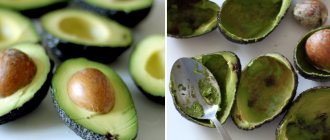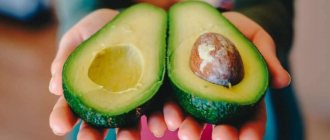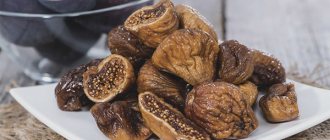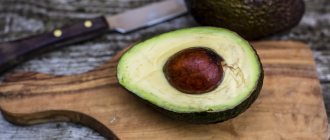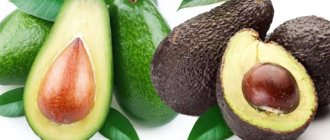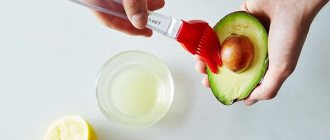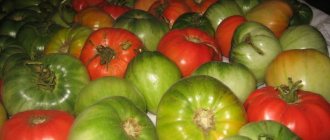In this article we will talk about how to correctly determine the ripeness of an avocado and how to store this fruit.
Avocados are commonly used in a variety of dishes, from salads to desserts. It is attractive not only for its taste, but also for the presence of vitamins and minerals in its composition. Most people perceive this fruit not as exotic, but as an everyday fruit that can be purchased at any time of the year. Despite such high popularity, many people do not know how to determine how ripe an avocado is. This is exactly what our article will talk about.
The most common varieties
The overseas fruit avocado, which is also often called the “alligator pear,” looks rather unusual to us. The outside of the fruit is covered with a dense, lumpy, dark green skin. When you cut it, you can see that, in addition to the oily pulp, there is a large bone inside, which is removed before use. Only the pulp of the fruit is suitable for eating, which gives dishes a soft texture and an original taste.
The number of varieties of this exotic fruit reaches 400, but only three varieties are found on sale, differing from each other both in appearance and taste:
- Florida. It is distinguished by a smooth surface of a greenish tint and a fairly dense fleshy part. This variety is better than others for salads, as it has low calorie content. The fruit can be eaten raw, after first peeling it with a knife and removing the large pit.
- Californian. This species has a dense brownish crust and very juicy, loose flesh. These fruits are sold in stores all year round. When purchasing, you need to pay attention to the appearance of the fruit in order to avoid purchasing a fruit with dents that are invisible at first glance.
- Pinkerton. A distinctive feature of this variety is its dark green peel with a large number of pimples. There is much more pulp in such fruits, since the seed is small. The tough skin of an avocado can be removed without using a knife. The internal structure is not damaged. Pinkerton is recommended for making rolls or sauces.
Useful information about avocados
Avocado is a pear-shaped berry fruit that can reach up to 20 centimeters in length and up to 2 kilograms in weight! There is a bone in the very center that should not be consumed.
Remember!
You should not eat the leaves, pits, or peels of avocados, because these components contain a toxic substance that can cause significant harm to human health.
Avocado oil can be consumed. It is quite healthy because the vitamin D content in it is much higher than in chicken eggs or butter.
Avocados are widely used in vegetarian cooking, where the fruits are used to add to rolls.
In medicine, this fruit is used for the prevention and treatment of many diseases; it is most suitable for preventing pathologies of the stomach and liver.
Avocado fruit can be grown independently in indoor conditions. To do this, you need to remove the outer part of the stone shell. Planting is recommended to a depth of 3 centimeters from the soil surface. The ripening time of the sprout is from one to two weeks.
The taste of the avocado itself can be different - from creamy with green flavors to nutty. But only ripe soft fruits have such taste qualities.
How to choose a ripe avocado in the store?
Since the ripeness of the fruit affects its taste, you need to know what external signs you need to pay attention to in order to choose an avocado in the store. In most cases, basic information about the product is indicated on the price tag. It can be used to determine the variety, the stage of fruit ripening, as well as the country from which the tropical fruit was imported.
To determine the ripeness of a California avocado, you need to press it with your finger. There should be no dents left on ripe fruits. If you bring an alligator pear to your ear and shake it in your hand, you should hear the bone rolling around inside. If the characteristic sound is not observed, then the fruit is not yet ripe.
Pinkerton and Florida avocados are much more difficult to choose from in the store. The fact is that the inside of these varieties remains very elastic even in a ripe state, so it is difficult to determine its ripeness by pressing.
In order to exclude the possibility of purchasing a low-quality avocado, it is carefully inspected from all sides. It should be free of cracks and dents, as well as any signs of diaper rash or rot. Ripe fruits have a rich dark color. However, when paying attention to the shade, you need to take into account whether it belongs to a specific variety.
If in a store you can feel the fruit with your hands, then its ripeness can be determined by pressing on the peel. The hole formed when pressed quickly disappears on ripened fruits. If the indentation remains, this indicates that the alligator pear is overripe. When the dent does not appear at all, the fruit should ripen. Unripe avocados can reach ripeness when stored at home within 4-5 days.
For the best tips on choosing avocados, watch the following video:
Rules for choosing color and softness
When determining the question of how to choose an avocado in a store, the appearance of the product is taken into account. There are different varieties: unripe, almost ripe, ripe and overripe. You can find out the degree of readiness by the shade of the peel, density, characteristics of the cutting, and aroma of the variety. The degree of ripeness can be determined after cutting the fruit.
Only ripe avocados are suitable for cooking and eating raw. The taste parameters of unripe varieties are reduced; overripe varieties are harmful, because contain toxic substances.
The fruit can reach readiness at home in 2-5 days, so experts recommend, if necessary, choosing an unripe avocado and storing it in a dark, cool place until the required level of softness and required taste characteristics are achieved.
Appearance (peel, fruit shade) may vary depending on the variety. Some species have a smooth surface, while others have pimply and wrinkled skin. There are more than 400 varieties of avocados on sale. The following varieties are sold in Russia:
- Bacon - has an elongated oval shape, a thin smooth peel of a rich green color. This variety of fruit has juicy snow-white pulp, neutral aroma and taste. The stone is medium-sized. The variety is slightly fatty, has a watery texture, and is suitable for strict diets. The weight reaches 150-170 g. The variety ripens in the autumn.
- Gwen - the variety has medium or large fruits of a round, slightly elongated shape. The skin is dense, has a lumpy texture, a dark green tint, the flesh of the fruit is yellowish-green, the taste is delicate with an eggy aftertaste. The avocado variety is high in fat. The bone is medium or small in size. The weight of the fruit is about 150-400 g. The variety ripens from September to December.
- Zutano - the variety has an elongated pear-shaped shape, smooth and thin green skin, which is easily peeled from the pulp. Inside the fruit is milky or pale yellow. The species has a delicate plant taste and a subtle apple aroma. The product has a high fat content, the fruit stone is round and large. The average weight is 170-400 g. The variety is offered in supermarkets all year round.
- Mexicola - a variety cultivated in Kazakhstan, the fruit is medium in size, weighs up to 100 g, the skin color is red-brown, and can be black-brown when ripe.
- Pinkerton is a pear-shaped variety with a skin with a rough texture and a rich green hue. The shape is elongated pear-shaped. Avocado pulp is soft yellow with a greenish tint, sweetish taste and aroma. The stone is compact, round in shape. The fat content of the variety is high. The average weight is 200-510 g, subspecies of the Pinkerton variety are grown all year round.
- Puebla - varieties are egg-shaped, the skin color is rich brown, the standard weight is 200-300 g.
- Reed - fruits are distinguished by a round, elongated configuration, the dense skin has a rough, pimply texture, and a dark green color. The pulp is distinguished by a soft golden hue, creamy aroma with pear and nutty notes. The variety has a high concentration of oils, the fruit seed is medium-sized and round in shape. The average weight reaches 220-500 g. The variety is offered in the summer season.
- Fuerte - a variety characterized by an elongated pear-shaped shape. The skin of the fruit is smooth, with a glossy shine, rich greenish-olive color, and is easy to peel. The variety has white flesh and a delicate creamy taste. The product has a high concentration of fats, the bone is compact and drop-shaped. Weight is 150-300 g. The variety is offered in stores during the summer and autumn seasons.
- Hass - a variety common in Russia, offered for purchase in different seasons. The fruit has an oval shape, a hard, dense brown-black skin with a pimply texture. The pulp of the fruit is milky or golden in color, the fruit is oily, with a high concentration of fats, a nutty aroma and taste. The product has a high concentration of fats, the bone is compact or medium in size. The average weight of the fruit reaches 140-340 g. The variety is offered in store departments all year round.
- Ettinger - a variety characterized by a pear-shaped elongated shape. The skin is thin, smooth, and the flesh of the fruit is golden-greenish in color with creamy, cheesy and nutty notes. This fruit variety has a low fat content. The stone is large, teardrop-shaped. The standard fruit weight is 150-300 g. The ripening period of the variety is September-January. The avocado variety can be stored for a long time without losing its taste characteristics.
- Californian - the variety is distinguished by a dense skin of a dark brown-green hue with a pimpled texture. The mass is soft, suitable for preparing pastes, sauces, rolls, pates and cream soups. The variety is distinguished by a delicate aroma, fatty consistency; the softened mass is spread on toast without additives for dietary nutrition.
- The Florida variety of the fruit is the most compact, the skin has a pimply texture. The variety is well stored, retains its taste characteristics for a long time, and is sold in stores all year round.
- Bernecker - this variety is distinguished by its delicate beige flesh, creamy taste, and medium fat content. The shape of the fruit is elongated pear-shaped, the skin is thin and smooth, pale green in color with specks. The average weight of the variety reaches 180-200 g. The fruit variety is sold in the autumn.
- Ryan - a variety of fruit has an oval or pear-shaped configuration, the flesh is soft yellow or deep yellow. The product has a high concentration of fats and has a large, rounded bone. The skin is a rich green hue, the texture is dense and bubbly. The fruit has a rich potato flavor with creamy and buttery notes. The weight of the fruit reaches 300-400 g. The avocado variety bears fruit from October to December. If removed from the tree early, the avocado variety does not have time to ripen and may deteriorate.
- Ardith - the variety has an oval shape, the flesh of the fruit is light white-golden in color with a green tint. The avocado variety has an average concentration of fat, the fruit pit is medium-sized, and the skin is dense, pimply, and has a rich green hue. The weight of the avocado variety reaches 150-180 g. The fruiting period occurs in spring. The taste is soft creamy with nutty notes.
- Choquette – round, ovoid, snow-white flesh, medium fat content of the fruit. The seed is small, oval in shape, and the skin is smooth and dark green in color. Weight is about 170-200 g, the variety ripens in autumn.
We recommend that you familiarize yourself with Kalina for the treatment of cough
Not ripe fruit
When choosing an avocado for transportation or storage, an unripe fruit is suitable, with 6-9 days remaining before it is ready. Unripe avocados are not eaten, so it is important to distinguish the degree of ripeness of the variety when purchasing at the supermarket.
Unripeness is indicated by hardness when pressed on the peel and a light green hue of the fruit. When cut, the pit stays tightly in the avocado. The unripe pulp has a dense structure, dry, with a bitter taste, which can negatively affect the taste characteristics of the prepared dish.
Unripe avocados contain the fatty acid persin, which has a negative effect on the body of people prone to allergic reactions to poultry and pets. If there is no individual intolerance to the product, you can use unripe fruits for frying and baking. When marinated, the dense mass will acquire a delicate creamy texture, rich taste and can be used as a sauce for meat and vegetable dishes, a spread on sandwiches, etc.
If it is necessary to ripen fruit, the following recommendations must be followed:
- it is important to select avocados without deformations, scratches, dents or other damage to the outer layer;
- the fruit should not be excessively hard;
- At home, avocados are wrapped in newsprint and placed in a cloth bag or wrapped in cloth;
- Chili peppers can be placed in burlap to speed up the ripening process;
- the temperature of the storage location should be room temperature (+20...+22°C);
- It is not recommended to place avocados in the refrigerator or store them in direct sunlight;
- optimally shaded space for ripening;
- a suitable ripening period is 3-8 days;
- It is not recommended to press on the skin to prevent deformation and the appearance of mold and rot.
Almost ripe
When deciding how to determine a ripe avocado, it is important to consider the purpose and period of use of the fruit. Almost ripe fruits are suitable for purchasing for the holidays, preparing menus for special events, when several days pass before using the product.
We recommend that you familiarize yourself with Live spruce in a pot
An avocado that is green in color and has a hard skin (almost ripe) will take about 3 days to ripen. Varieties with a rich green hue and soft skin ripen in 1-2 days. To speed up ripening, you can cover the avocado with plastic wrap or cloth and keep it at a temperature of +19...+22°C.
Ripe avocado
Ripe avocado is used in salads, for making smoothies, pastas and sauces for sandwiches; how to choose a ripe fruit is decided taking into account the recommendations of experts.
The ripe variety has tender pulp with an oily texture and is distinguished by a rich taste and aroma. When cutting the fruit, the stone quickly separates from the pulp of the fruit. The avocado skin should be a rich dark green color.
The skin should be medium soft; when pressed, the avocado peel will be slightly pressed. If it is necessary to use the product for preparing dishes after a few days, this avocado must be stored in the refrigerator or in a dark, cool place (loggia, balcony). The skin of a ripe avocado should be a uniform green color.
A high-quality product should retain elasticity and no dents remain after pressing. The stalk of a ripe fruit should be a rich green color. When the product is shaken, the seed makes a knocking sound, indicating that the fruit is ripening. The delicate aroma can be felt through the peel.
Overripe fruit
When deciding how to determine a ripe avocado, it is important to consider the signs of an overripe fruit. It is not recommended to purchase fruit if you have the following symptoms:
- excessive softness of the peel, surface deformations remaining after pressing the peel;
- presence of an unpleasant odor;
- when cut, the flesh is darkened, damage indicates that the avocado has spoiled and is unsuitable for cooking;
- a brown-green or black-brown tint of the skin is evidence of spoiled and rotting fruit.
However, there are exceptions to the rule; some varieties of avocado have a brown skin tone.
How to make sure an avocado is ripe?
In order to determine how ripe the fruit you purchased in the store is, you first need to separate the stalk and inspect the recess. If it has a light brown tint, then the fruit is at optimal ripeness. If it turns out to be black, then the fruit is already overripe and is not recommended to be eaten.
Ripeness can also be distinguished by the consistency and color of their interior:
- the pulp of overripe fruits is very moist and has a light brown tint;
- a perfectly ripe, tasty fruit has sufficiently moist, bright green flesh;
- pulp of insufficient ripeness is yellowish or greenish.
The consistency of the pulp is also important in determining the degree of ripeness. The edible part of the ripe fruit is very tender and quickly spreads on bread. If it is not soft enough, then the fruit needs to ripen. Unripe fruits can be used as an additional ingredient for salads. Their pulp is well cut into pieces and looks aesthetically pleasing in dishes.
How to help it ripen?
There are several ways to speed up fruit ripening. Choosing one of them depends on how quickly you need results. If you are not in a hurry, and the salad for which you bought the avocado should not be eaten for dinner, choose the most time-consuming method. It will provide the highest quality results. If you need ripe fruit right now, there are proven life hacks for this case.
In the microwave
To quickly ripen the fruit, you can use the microwave. You need to understand that this express method will worsen the taste of the product and make it less healthy, since during heating in the microwave, many of the valuable substances of the avocado will be destroyed. But this method allows you to make a “wooden” fruit quite suitable for consumption. This avocado is best used in salads. The flavor of the other ingredients will detract from the avocado. It is not recommended to use the product for dishes where avocado is the main flavor.
The instructions are simple:
- wash the fruit and dry it;
- using a knife or toothpicks, make several punctures in the peel in different places (this is necessary to prevent the fruit from being torn into pieces in the microwave);
- Place the product in a microwave-safe container and turn on the appliance at full power for 30 seconds.
If the fruit was very green, the time is doubled. After cooling, peel off the skin.
In a paper bag or newspaper
The most correct way to get a ripe avocado is also the longest. But the result will definitely not disappoint, since the taste of the fruit will not be affected, and its composition will remain rich.
Unripe avocados are placed in a paper bag and left on the table or on a kitchen cabinet shelf for 2 to 3 days. It is worth looking into the package every day and checking the condition of the product. To determine whether it is ripe, you need to feel it or shake it in your hand, listening to the “sound” of the seed.
Apples and bananas will help speed up the process. Put them in a bag and the process will go faster. The secret is that they emit ethylene, which activates the ripening processes of fruits. By the way, proximity to bananas and apples helps make not only avocados ripe, but also other vegetables and fruits.
Important! The package should only be at room temperature. If it is placed in the refrigerator, the avocado will not ripen and will spoil.
In addition to a paper bag, you can use old newspaper or food paper. Wrap the fruit in it and leave it for a couple of days.
In foil
Similar to a paper bag, you can also use foil. By wrapping an avocado with a banana or apple in foil, you can ensure a high concentration of ethylene around the fruit. Ethylene will speed up the ripening of the fruit.
In boiling water
If you need a ripe avocado as quickly as possible, you can soften it with boiling water. The fruit is first peeled and the pit is removed. To speed up the process, the pulp can be cut into small pieces. The pulp is placed in a deep plate and poured with boiling water for 2 - 3 minutes, then the water is drained. The chilled pulp is suitable for various snacks and salads.
In the oven
Having bought a green fruit, do not despair, as you can get a ripe avocado by keeping it in the oven. To do this, the fruits are washed and dried, then wrapped in foil and placed on a baking sheet. It is sent to the oven, preheated at 200 degrees, for 10 minutes. The fruits will become softer and can be used to make salads and snacks. However, it is not recommended to heat them for longer than 10 minutes. With prolonged exposure to temperature, the pulp will become bitter, and the amount of nutrients in it will be significantly reduced.
How to improve cut fruit?
You can also soften chopped avocados using the microwave. The pieces are placed in a plastic container with a lid and placed in the microwave. Cut avocado can also be softened by pouring boiling water over it.
If you cut the fruit into halves and realize that the pulp is too hard, you can improve its taste as follows:
- moisten the cut halves with lemon juice;
- fold both parts together, wrap them in cling film;
- Place the fruit in a plastic box and put it in the refrigerator.
Check every day to see if the fruit has become softer by pressing on the peel. As soon as the pulp begins to press through, it can be eaten.
Main signs of ripe fruit
In addition to the rules discussed above for determining the ripeness of an avocado, in order to choose a quality product, you need to take into account standard factors that apply to most fruit crops. Its surface must be clean, without any damage, defects or signs of parasites. Important signs of a good ripe avocado include:
- dark shade of the peel, which immediately differs from unripe fruits;
- uniform skin color without light areas;
- elastic surface without dents;
- the stalk is bright green;
- pleasant smell reminiscent of nut butter.
You can choose an avocado without focusing on its shape, since it may differ for ripe fruits of different varieties. Florida and Pinkerton are shaped like a small elongated pear, while Californian has a more rounded outline. The fruits of these species practically do not differ in taste. You can feel the difference only in ripe and overripe or unripe fruits.
Very often, preference when choosing is given to larger fruits, but it should be noted that size is not an indicator of ripeness. The bone in them is also very large, which affects the amount of tasty pulp. Its shape in different varieties can be round or oblong.
Chemical composition and beneficial properties
It’s enough to simply come across unripe or overripe fruit on the shelves of retail chains. But what about those consumers who want to make the right choice in the direction of quality avocados?
Only the pulp of the fruit can be eaten. The pulp contains quite a lot of useful substances, vitamins B, C, A, K, E, folic acid, as well as many useful mineral compounds: phosphorus, copper, sodium, iodine and iron. This fruit is perfect for those who want to lose weight naturally, since it contains easily digestible fat groups that eliminate cholesterol.
In addition, avocado is perfect for people who have problems with the nervous system, since the fruit contains heptulose, which reduces drowsiness and invigorates the body.
One avocado fruit contains the following beneficial substances:
- About 72 g of drinking water is approximately 3% of the norm per day.
- About 2 g of protein is approximately 2.5% of the norm per day.
- About 15 g of fat is approximately 23% of the norm per day.
- About 2 g of carbohydrates is approximately 1.5% of the norm per day.
It follows that the final energy value of the avocado fruit is 670 kJ - this is 11.5% of the norm per day. And 160 kcal is 11.5% of the norm per day.
We recommend reading:
how to properly peel an avocado
Read
Which avocado is not recommended to buy?
To enjoy the taste and aroma of a ripe avocado, and not feel disappointed, you need to know how to choose it and which fruits it is better to avoid purchasing:
- the surface of the peel with defects such as dents, cuts or cracks may indicate poor quality of the product, which may be spoiled and hazardous to health;
- It is better not to buy overripe fruit on the rind of which visible indentations remain after pressing with a finger;
- the surface of an avocado with spots and dents indicates the development of the rotting process inside it;
- if it is too hard to the touch, it will probably be unripe and cannot be eaten right away;
- a clear sign of overripeness is the brown stalk;
- insufficient ripeness can be judged by the light green cuttings with a yellow tint;
- the absence of a pronounced odor is observed in avocados that were grown using harmful chemicals;
- It is better to avoid purchasing a fruit whose surface is covered with wax or other specific compounds, since washing them off before use will be very problematic.
Meet the avocado
Do you think avocado is a fruit or a vegetable? The fruit grows on an evergreen tree of the laurel family. From a botanical point of view, it is considered a single-seeded berry, although the taste is not sweet. Externally, the fruit looks like a pear with a rough peel and even has an alternative name in Russian - “alligator pear.”
How to store at home?
In order for the avocado to remain tasty for a long time and so that it does not begin to rot from the inside, after purchasing it, it must be placed in a dark place where the sun's rays do not reach. The optimal storage temperature is +10 °C. If there are several fruits, they should be placed at a short distance from each other. The maximum storage duration under such conditions is 7 days.
Avocados can be stored in the refrigerator for longer than 10 days, after wrapping them in newspaper. The bottom vegetable drawer is best for storage.
In order for an unripe avocado to ripen, it is recommended to wrap it in a paper towel and leave it at home at room temperature for 4-5 days. Culinary experts recommend placing a banana in a paper wrapper next to it to speed up the process.
Cut fruit can be stored in the refrigerator in two ways:
- If the pit has been removed, apply lime or lemon juice to the cut of the pulp using a silicone brush and place the halves in a plastic bag or food foam. You can preserve the freshness of the product in this way for 1-2 days.
- The avocado will keep a little longer if you leave the pit in one of its halves. You need to create a sealed barrier by analogy with the first option. In this case, lemon juice can be replaced with olive oil.
Freezing peeled avocados is also allowed. Before placing it in the freezer, you need to peel it and puree the pulp using a food processor or blender. The resulting mass is placed in a container or other sealed container, leaving about 2-3 cm of free space on top. In the form of puree, it retains its taste and aroma for six months.
Fruit storage rules
Knowing how to choose the right ripe fruit, it will not hurt to learn how to store it. The storage conditions for ripe and unripe avocados are different.
Refrigerator conditions are best for storing ripe fruits. They are placed in a compartment for vegetables and fruits. It is convenient to keep them in the refrigerator in special food containers or zip bags. Under such conditions, the product can be stored for up to 5 days. If, for example, you saw beautiful avocados in the store a week before the New Year, you can safely buy them. They will keep in the refrigerator until the holiday without any problems.
The refrigerator is not suitable for storing unripe fruits. At low temperatures they will not be able to ripen, but will only deteriorate. For unripe fruits, room temperature is needed.
Important! Cut fruits are stored in the refrigerator only in closed containers. The pulp strongly absorbs foreign odors.
If the fruit has already been cut, its storage conditions are slightly different. The pulp tends to darken, like an apple. To prevent it from turning black, the cut should be greased with vegetable oil or lemon juice. Lime juice will also work. By the way, it is thanks to lemon juice that guacamole sauce retains its beautiful light green hue for a long time.
Tip: to prevent the pulp from darkening and becoming windy, the cut fruit can be wrapped in cling film.
